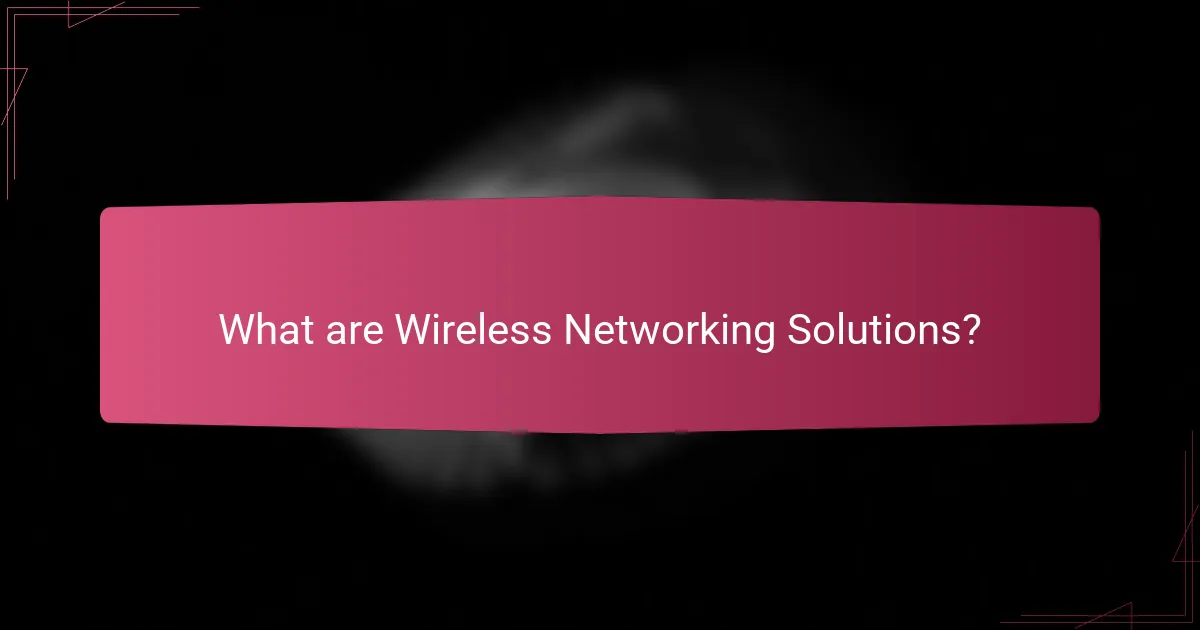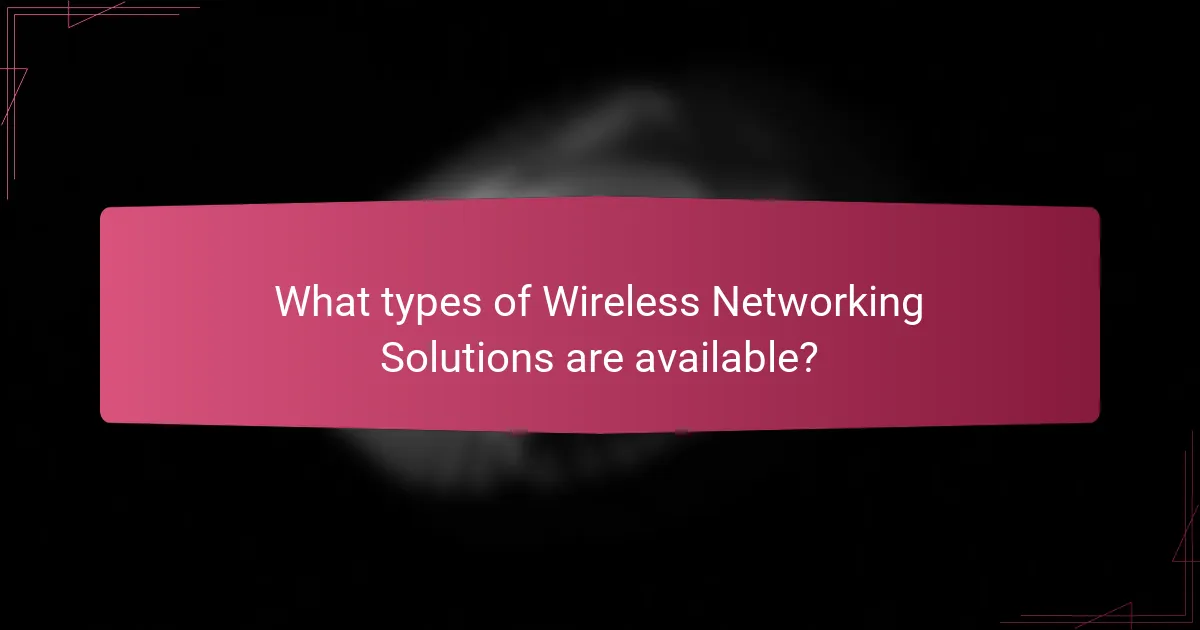
What are Wireless Networking Solutions?
Wireless networking solutions are technologies that enable devices to connect and communicate over a wireless medium. These solutions include Wi-Fi, Bluetooth, and cellular networks. They facilitate data transmission without the need for physical cables. Wireless networking solutions are essential for mobile devices and IoT applications. According to the Cisco Annual Internet Report, by 2023, there will be over 29 billion networked devices globally. This growth highlights the importance of wireless networking solutions in modern connectivity.
How do Wireless Networking Solutions operate?
Wireless networking solutions operate by transmitting data through radio waves. These systems utilize various protocols to connect devices without physical cables. Wireless access points send and receive signals to and from devices like smartphones and laptops. Data packets are encoded and modulated for transmission over the air. The most common standards are Wi-Fi, which operates on different frequency bands. Security protocols like WPA2 protect the data during transmission. Wireless networking solutions enable mobility and flexibility in network access. They are widely used in homes, businesses, and public spaces for connectivity.
What technologies are used in Wireless Networking Solutions?
Wireless networking solutions utilize several key technologies. These include Wi-Fi, which enables local area networking without physical cables. Bluetooth technology facilitates short-range wireless communication between devices. Zigbee is used for low-power, low-data-rate applications, particularly in home automation. Cellular technologies, such as 4G and 5G, provide wide-area wireless connectivity. Additionally, mesh networking enhances coverage by allowing devices to relay data between each other. These technologies collectively support various applications in wireless networking solutions, ensuring reliable and efficient communication.
How do these technologies impact connectivity?
Wireless networking technologies significantly enhance connectivity by enabling seamless communication between devices. They facilitate high-speed data transfer, which improves user experiences in various applications. Technologies such as Wi-Fi, Bluetooth, and cellular networks provide different ranges and bandwidths. Wi-Fi networks offer extensive coverage and support multiple devices simultaneously. Bluetooth is ideal for short-range communication, connecting devices like headphones and smartwatches. Cellular networks allow connectivity over vast distances, supporting mobile internet access. According to a report by the International Telecommunication Union, global internet access increased to 4.9 billion users in 2021, highlighting the impact of wireless technologies on connectivity. These advancements enable real-time communication, remote work, and access to cloud services. Overall, wireless networking technologies are crucial for modern connectivity solutions.
What are the key benefits of Wireless Networking Solutions?
Wireless networking solutions provide flexibility, scalability, and cost-effectiveness. They enable users to connect devices without physical cables. This enhances mobility, allowing users to access the network from various locations. Wireless networks can be easily expanded by adding new devices without extensive infrastructure changes. According to a report by MarketsandMarkets, the global wireless networking market is expected to grow significantly, indicating increasing adoption. Additionally, wireless solutions reduce installation costs associated with cabling. They also facilitate easier network management and maintenance. Overall, these benefits make wireless networking solutions a preferred choice for many organizations.
How do Wireless Networking Solutions enhance user experience?
Wireless networking solutions enhance user experience by providing seamless connectivity and high-speed internet access. They eliminate the need for physical cables, allowing users to connect devices from anywhere within the network range. This flexibility promotes mobility and convenience in various environments, such as homes and offices.
Moreover, advanced wireless technologies, such as Wi-Fi 6, offer increased bandwidth and reduced latency. These improvements lead to faster download and upload speeds, improving activities like streaming and online gaming.
Wireless networks also support multiple devices simultaneously without significant performance degradation. This capability is essential in today’s multi-device households and workplaces.
In addition, features like mesh networking enhance coverage and eliminate dead zones. This ensures a consistent and reliable connection throughout larger areas.
According to a study by the Wi-Fi Alliance, users experience up to 40% faster speeds with Wi-Fi 6 compared to previous standards. This statistic underscores the impact of modern wireless solutions on user satisfaction and overall experience.
What cost savings can be achieved with Wireless Networking Solutions?
Wireless Networking Solutions can achieve significant cost savings in various areas. They reduce the need for extensive cabling infrastructure, which can be expensive to install and maintain. Wireless solutions also lower labor costs associated with physical network setup and modifications.
Additionally, they offer flexibility and scalability, allowing businesses to expand their networks without substantial investments. According to a study by Cisco, businesses can save up to 30% on operational costs by implementing wireless networking.
Moreover, wireless solutions often lead to increased productivity, as employees can connect from anywhere, reducing downtime. Overall, these factors contribute to a more cost-effective networking approach.

What types of Wireless Networking Solutions are available?
There are several types of wireless networking solutions available. These include Wi-Fi networks, which provide local area connectivity. Cellular networks offer wide area coverage for mobile devices. Bluetooth technology facilitates short-range communication between devices. Satellite networks enable connectivity in remote areas. Mesh networks enhance coverage by using multiple nodes. Each solution serves different needs based on range, speed, and application. For example, Wi-Fi is commonly used in homes and offices, while cellular networks are essential for smartphones.
What are the different types of wireless networks?
There are several types of wireless networks. These include Wi-Fi networks, cellular networks, satellite networks, and Bluetooth networks. Wi-Fi networks are commonly used for local area connections. They typically operate on standards such as 802.11a/b/g/n/ac. Cellular networks provide mobile connectivity over extensive geographic areas. They are categorized into generations, such as 4G and 5G. Satellite networks enable communication in remote areas by using satellites in orbit. Bluetooth networks facilitate short-range communication between devices. Each type serves different purposes and has unique specifications.
How do Wi-Fi networks differ from cellular networks?
Wi-Fi networks differ from cellular networks primarily in their coverage and technology. Wi-Fi operates within a limited range, typically around 150 feet indoors and up to 300 feet outdoors. Cellular networks provide broader coverage, often spanning several miles through cell towers.
Wi-Fi uses unlicensed radio frequencies, such as 2.4 GHz and 5 GHz bands. Cellular networks operate on licensed frequencies, which are regulated by government authorities. Wi-Fi is generally faster for local data transfer, offering speeds that can exceed 1 Gbps. Cellular networks, while slower in local contexts, provide consistent connectivity over larger distances.
Wi-Fi requires a router or access point for connectivity. Cellular networks rely on mobile towers and infrastructure for service. Additionally, Wi-Fi is often free or low-cost for users, while cellular networks typically involve subscription fees.
Security protocols also differ; Wi-Fi networks often use WPA2 or WPA3 encryption, while cellular networks utilize encryption standards like LTE security protocols. These distinctions highlight the unique roles each network type plays in wireless communication.
What are the characteristics of mesh networks?
Mesh networks are characterized by their decentralized architecture. Each node in a mesh network can communicate with multiple other nodes. This structure enhances network reliability and coverage. If one node fails, data can be rerouted through other nodes. Mesh networks can self-heal, automatically finding alternative paths for data transmission. They support scalability, allowing the addition of new nodes without significant reconfiguration. The network can adapt to changes in the environment or user demand. Additionally, mesh networks often provide better performance in terms of latency and bandwidth compared to traditional networks.
What are the advantages and disadvantages of each type?
The advantages and disadvantages of wireless networking solutions vary by type. Each type offers unique benefits and drawbacks.
Wi-Fi networks provide high-speed internet access and are widely available. They support multiple devices simultaneously. However, Wi-Fi can be susceptible to interference and security vulnerabilities.
Bluetooth technology enables short-range connectivity and low power consumption. It is ideal for connecting peripherals like headphones. However, Bluetooth has limited range and lower data transfer speeds compared to Wi-Fi.
Cellular networks offer extensive coverage and mobility. They allow users to stay connected while on the move. However, cellular data can be costly and may have slower speeds in congested areas.
Satellite internet provides coverage in remote locations. It is useful where traditional internet options are unavailable. However, it often suffers from high latency and weather-related disruptions.
Each wireless networking type has specific advantages and disadvantages that influence their suitability for different applications.
How does scalability differ among types of Wireless Networking Solutions?
Scalability in wireless networking solutions varies significantly among different types. For instance, Wi-Fi networks can easily scale by adding more access points. This allows for increased coverage and user capacity without major infrastructure changes. In contrast, cellular networks require more complex adjustments for scalability. Expanding a cellular network often involves upgrading base stations and backhaul connections. Mesh networks provide a flexible scalability option, as they can expand by adding more nodes without centralized control. However, this can lead to increased latency if not managed properly. Point-to-point wireless solutions typically have limited scalability due to their fixed nature. They require new installations for additional connections. Each type of wireless solution has unique scalability characteristics that impact deployment and performance.
What are the typical use cases for each type?
Wireless networking solutions include various types such as Wi-Fi, Bluetooth, and cellular networks. Wi-Fi is typically used for high-speed internet access in homes and offices. It supports multiple devices simultaneously, making it ideal for environments like cafes and schools. Bluetooth is commonly used for short-range data transfer between devices, such as connecting headphones to smartphones. It is effective for wearable technology and peripheral devices. Cellular networks provide mobile internet access over large areas. They are essential for smartphones and IoT devices, enabling connectivity on the go. Each type serves specific needs based on range, speed, and application requirements.

How are performance metrics measured in Wireless Networking Solutions?
Performance metrics in Wireless Networking Solutions are measured using various quantitative and qualitative methods. Key metrics include throughput, latency, packet loss, and signal strength. Throughput quantifies the data transfer rate, typically measured in Mbps. Latency assesses the time taken for data to travel from source to destination, usually expressed in milliseconds. Packet loss measures the percentage of packets that fail to reach their destination, impacting overall network reliability. Signal strength indicates the quality of the wireless signal, often measured in dBm. Tools such as network analyzers and performance monitoring software are commonly used to gather these metrics. Regular testing and analysis help in optimizing network performance and ensuring quality of service.
What key performance indicators are used to evaluate Wireless Networking Solutions?
Key performance indicators used to evaluate Wireless Networking Solutions include throughput, latency, and packet loss. Throughput measures the data transfer rate, indicating how much data is successfully transmitted over the network. Latency assesses the time it takes for data to travel from source to destination, impacting user experience. Packet loss refers to the percentage of packets that do not reach their destination, affecting the quality of service. Additionally, signal strength and coverage area are crucial for determining the effectiveness of wireless networks. These metrics collectively provide a comprehensive view of network performance and reliability.
How does bandwidth affect performance?
Bandwidth directly affects performance by determining the maximum data transfer rate of a network connection. Higher bandwidth allows more data to be transmitted simultaneously. This leads to faster download and upload speeds. For example, a connection with 100 Mbps can transfer more data than one with 10 Mbps. Insufficient bandwidth can result in network congestion. This congestion causes delays and slower response times. Research shows that user experience improves significantly with increased bandwidth. A study by the Federal Communications Commission found that higher bandwidth correlates with better performance in streaming and online gaming.
What role does latency play in network performance?
Latency significantly affects network performance. It refers to the time delay experienced in data transmission. High latency can lead to slower response times in applications. This is particularly critical for real-time services like video conferencing and online gaming. A latency of over 100 milliseconds can degrade user experience. Conversely, low latency, typically below 20 milliseconds, enhances performance. Studies show that reducing latency can improve throughput and user satisfaction. For instance, a 2019 study by the International Telecommunication Union highlighted that lower latency networks lead to better application performance and user engagement.
How can performance be optimized in Wireless Networking Solutions?
Performance in Wireless Networking Solutions can be optimized through several key strategies. First, implementing advanced technologies like MU-MIMO enhances data throughput. This allows multiple users to connect simultaneously without significant drops in speed. Second, optimizing channel selection reduces interference from other networks. Tools like spectrum analyzers can identify the least congested channels. Third, adjusting the placement of access points improves coverage and signal strength, minimizing dead zones. Fourth, utilizing Quality of Service (QoS) settings prioritizes critical applications, ensuring reliable performance for essential tasks. Lastly, regular firmware updates maintain security and performance enhancements, as manufacturers often release improvements. These strategies collectively enhance the efficiency and reliability of wireless networking solutions.
What techniques can improve signal strength?
Techniques to improve signal strength include using a signal booster, optimizing router placement, and upgrading antennas. A signal booster amplifies the existing signal, enhancing coverage. Placing the router in a central location minimizes obstructions and maximizes range. Upgrading to high-gain antennas can direct the signal more effectively. Additionally, reducing interference from other electronic devices can improve clarity and strength. Regularly updating firmware ensures optimal performance and security. These strategies collectively enhance the overall wireless network experience.
How does network congestion impact performance metrics?
Network congestion negatively affects performance metrics by increasing latency and reducing throughput. When too many devices access the network simultaneously, data packets experience delays. This delay can lead to higher round-trip times for data transmission. Throughput, or the amount of data transmitted in a given time, decreases as congestion increases. Studies show that congestion can lead to packet loss, further degrading performance. For example, a study by the International Telecommunication Union found that high congestion levels can reduce throughput by up to 50%. Additionally, user experience suffers as applications become slower and less responsive under congested conditions.

What security features are essential in Wireless Networking Solutions?
Essential security features in wireless networking solutions include encryption, authentication, and network access control. Encryption protects data transmitted over the network, making it unreadable to unauthorized users. Common encryption protocols include WPA2 and WPA3, which secure wireless communications. Authentication verifies the identity of users and devices connecting to the network. This can be achieved through methods such as passwords, digital certificates, or two-factor authentication. Network access control limits access to authorized users only. This is often implemented through MAC address filtering and VLAN segmentation. Regular software updates and patch management are also critical for maintaining security. These practices help protect against vulnerabilities and exploits.
What are the common security threats to Wireless Networking Solutions?
Common security threats to wireless networking solutions include unauthorized access, eavesdropping, and denial of service attacks. Unauthorized access occurs when attackers gain entry to a network without permission. Eavesdropping involves intercepting data transmitted over the network. Denial of service attacks aim to disrupt network services, making them unavailable to legitimate users. Other threats include man-in-the-middle attacks and rogue access points. Man-in-the-middle attacks occur when an attacker secretly relays and alters communications between two parties. Rogue access points are unauthorized devices that can compromise network security. According to the 2021 Verizon Data Breach Investigations Report, 28% of breaches involved wireless networks, highlighting the prevalence of these threats.
How can unauthorized access be prevented?
Unauthorized access can be prevented through a combination of strong authentication methods and network security protocols. Implementing WPA3 encryption enhances the security of wireless networks. Regularly updating firmware on routers and devices fixes vulnerabilities. Utilizing firewalls creates barriers against unauthorized access attempts. Employing a Virtual Private Network (VPN) encrypts data transmissions, adding a layer of protection. Monitoring network traffic helps detect and respond to suspicious activities promptly. Lastly, educating users about safe practices reduces the risk of social engineering attacks. These strategies collectively fortify wireless networks against unauthorized access.
What encryption methods are recommended for securing wireless networks?
WPA3 is the recommended encryption method for securing wireless networks. It provides enhanced security features compared to its predecessor, WPA2. WPA3 uses stronger encryption protocols and offers protections against brute-force attacks. WPA3 also includes individualized data encryption, ensuring that each device connected to the network has its data encrypted separately. According to the Wi-Fi Alliance, this method significantly improves the security of wireless communications. Additionally, WPA3 is designed to be more resilient to password guessing attempts. For networks that still use WPA2, it is crucial to ensure that AES encryption is enabled for optimal security.
What best practices should be followed for securing Wireless Networking Solutions?
Use strong encryption protocols like WPA3 to secure wireless networks. Strong encryption prevents unauthorized access and data breaches. Change default SSIDs and passwords to unique values. This practice reduces the risk of attacks targeting common defaults. Regularly update firmware on wireless devices. Updates often contain security patches that protect against vulnerabilities. Implement a guest network for visitors. This keeps the main network secure from potential threats. Disable WPS (Wi-Fi Protected Setup) to prevent unauthorized access through vulnerabilities. Monitor network traffic for unusual activity. This helps identify potential security breaches early. Use a firewall to filter incoming and outgoing traffic. Firewalls provide an additional layer of security against attacks.
How can regular updates enhance security?
Regular updates enhance security by patching vulnerabilities in software and hardware. These updates address known security flaws that can be exploited by attackers. For instance, the 2017 Equifax breach occurred due to unpatched software vulnerabilities. Regular updates also improve security protocols, making it harder for unauthorized access. They often include new features that enhance overall system resilience. According to a report by the Cybersecurity and Infrastructure Security Agency, timely updates can reduce the risk of cyber incidents significantly. Keeping systems updated ensures compliance with security standards, which is crucial for protecting sensitive data.
What role does user training play in network security?
User training plays a critical role in network security. It equips individuals with knowledge about potential threats. This knowledge helps them recognize phishing attempts and social engineering tactics. Trained users are less likely to fall victim to cyberattacks. According to a study by the Ponemon Institute, organizations with effective security awareness training can reduce the risk of breaches by up to 70%. Regular training reinforces security policies and best practices. It fosters a culture of security awareness within the organization. This proactive approach significantly enhances the overall security posture of the network.
What troubleshooting tips can help with Wireless Networking Solutions?
Restart the router to resolve connectivity issues. Power cycling can clear temporary glitches. Check for firmware updates to enhance performance and security. Ensure the wireless signal is strong and unobstructed by walls or other devices. Change the Wi-Fi channel to reduce interference from nearby networks. Verify that the correct network password is being used. Use network diagnostic tools to identify issues. Check device compatibility with the network standards.
Wireless networking solutions encompass technologies that enable devices to connect and communicate without physical cables, including Wi-Fi, Bluetooth, and cellular networks. This article explores the operation, types, and key benefits of these solutions, emphasizing their impact on connectivity and user experience. Additionally, it examines performance metrics such as throughput and latency, as well as essential security features and common threats faced by wireless networks. Key troubleshooting tips and best practices for maintaining security are also discussed to enhance the overall effectiveness of wireless networking solutions.




